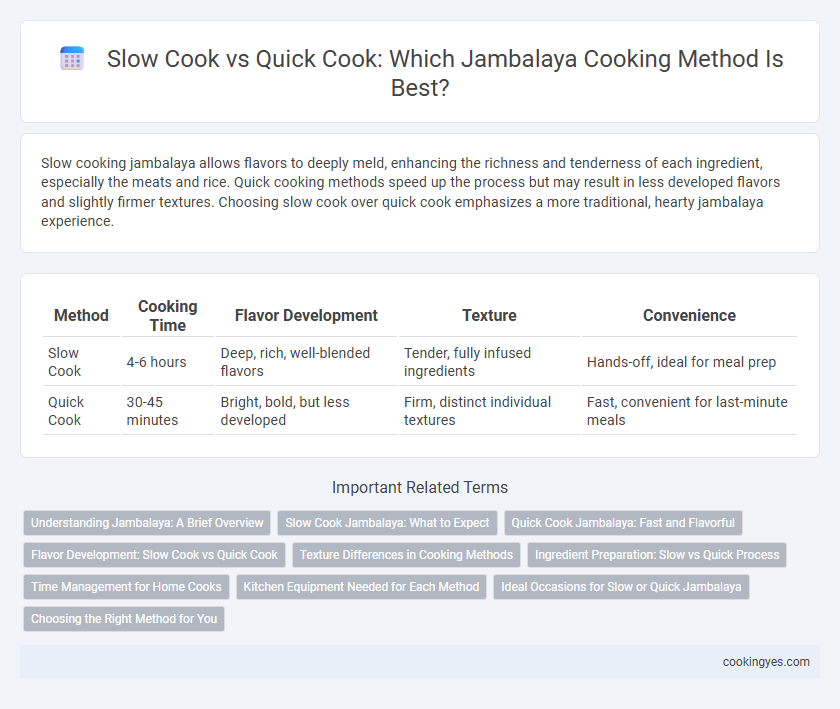Slow cooking jambalaya allows flavors to deeply meld, enhancing the richness and tenderness of each ingredient, especially the meats and rice. Quick cooking methods speed up the process but may result in less developed flavors and slightly firmer textures. Choosing slow cook over quick cook emphasizes a more traditional, hearty jambalaya experience.
Table of Comparison
| Method | Cooking Time | Flavor Development | Texture | Convenience |
|---|---|---|---|---|
| Slow Cook | 4-6 hours | Deep, rich, well-blended flavors | Tender, fully infused ingredients | Hands-off, ideal for meal prep |
| Quick Cook | 30-45 minutes | Bright, bold, but less developed | Firm, distinct individual textures | Fast, convenient for last-minute meals |
Understanding Jambalaya: A Brief Overview
Jambalaya, a traditional Creole dish, offers two primary cooking methods: slow cook and quick cook, each impacting flavor and texture differently. Slow cooking allows spices, rice, and proteins to meld gradually, producing a rich, deeply infused taste and tender texture, while quick cooking accelerates the process by sauteing ingredients and simmering briefly, resulting in a fresher but less developed flavor profile. Understanding these methods helps home cooks choose based on time constraints and desired flavor intensity.
Slow Cook Jambalaya: What to Expect
Slow cook jambalaya develops deeper, more complex flavors as the ingredients meld over several hours, allowing the rice to absorb the smoky, spicy broth fully. This method results in tender meats, such as sausage and chicken, and vegetables that become richly infused with Cajun seasonings, creating a harmonious and hearty dish. Expect a satisfying, well-balanced texture where every bite bursts with layered, slow-cooked taste nuances often missing in quick cook versions.
Quick Cook Jambalaya: Fast and Flavorful
Quick cook jambalaya delivers bold, authentic flavors by rapidly sauteing the meat, vegetables, and spices before simmering with rice and broth, enabling a rich taste in under 30 minutes. Using ingredients like smoked sausage, chicken, shrimp, bell peppers, onions, celery, and Cajun seasoning maximizes depth while maintaining simplicity. This method preserves texture and infuses spices quickly, perfect for fast, delicious Creole and Cajun meals.
Flavor Development: Slow Cook vs Quick Cook
Slow cooking jambalaya enhances flavor development by allowing spices, meats, and vegetables to meld gradually, resulting in a rich, deeply layered taste profile. Quick cooking methods preserve the brightness of individual ingredients but often lack the complexity and depth achieved through extended simmering. For authentic Cajun jambalaya, slow cooking is preferred to unlock maximum savory richness and tender texture.
Texture Differences in Cooking Methods
Slow-cooked jambalaya develops a richer, more integrated texture as the rice absorbs flavors gradually, resulting in tender, well-blended ingredients. Quick-cooked jambalaya features a firmer, distinct texture with grains that remain separate and ingredients retaining more individual bite. The choice of cooking method directly impacts the mouthfeel, with slow cooking enhancing softness and cohesion while quick cooking preserves texture contrast.
Ingredient Preparation: Slow vs Quick Process
Slow cooking jambalaya involves finely chopping and sauteing ingredients like onions, bell peppers, celery, and meats to develop deep, layered flavors over extended heat, allowing spices and broth to thoroughly infuse the rice. Quick cooking methods often rely on pre-cut vegetables and pre-cooked meats, combining ingredients rapidly in a single pot to reduce preparation time while sacrificing some depth of flavor. The slow preparation process enhances texture and complexity, whereas quick preparation prioritizes convenience and speed.
Time Management for Home Cooks
Slow cook jambalaya enhances the depth of flavors by allowing spices and ingredients to meld over several hours, perfect for home cooks who can plan and set it early in the day. Quick cook jambalaya uses high heat and shorter cooking times, ideal for busy schedules seeking a fast yet flavorful meal without compromising essential taste elements. Time management techniques such as prepping ingredients beforehand and multitasking with side dishes optimize efficiency regardless of the method chosen.
Kitchen Equipment Needed for Each Method
Slow cook jambalaya requires a slow cooker or crockpot, which allows for even heat distribution and prolonged cooking to enhance flavors. Quick cook jambalaya relies on a heavy-bottomed skillet or Dutch oven paired with a stovetop for rapid sauteing and simmering. Proper kitchen equipment ensures optimal texture and taste for each cooking method.
Ideal Occasions for Slow or Quick Jambalaya
Slow-cooked jambalaya offers rich, deeply developed flavors ideal for leisurely family gatherings or weekend dinners where time permits simmering the ingredients to perfection. Quick-cook jambalaya suits busy weeknights or casual get-togethers, providing a flavorful, satisfying meal in under 30 minutes without sacrificing the classic Louisiana taste. Choosing the method depends on your schedule and the occasion's vibe, balancing preparation time with desired culinary depth.
Choosing the Right Method for You
Slow cook jambalaya enhances flavor development by allowing spices, meats, and vegetables to meld over several hours, creating a rich, deep taste ideal for traditionalists and those with ample time. Quick cook methods use higher heat and shorter cooking times, preserving texture and enabling faster meal preparation, suited for busy schedules or weeknight dinners. Selecting the right method depends on desired flavor complexity, time availability, and preferred texture, ensuring a satisfying jambalaya experience tailored to individual needs.
Slow cook vs Quick cook for Jambalaya method Infographic

 cookingyes.com
cookingyes.com